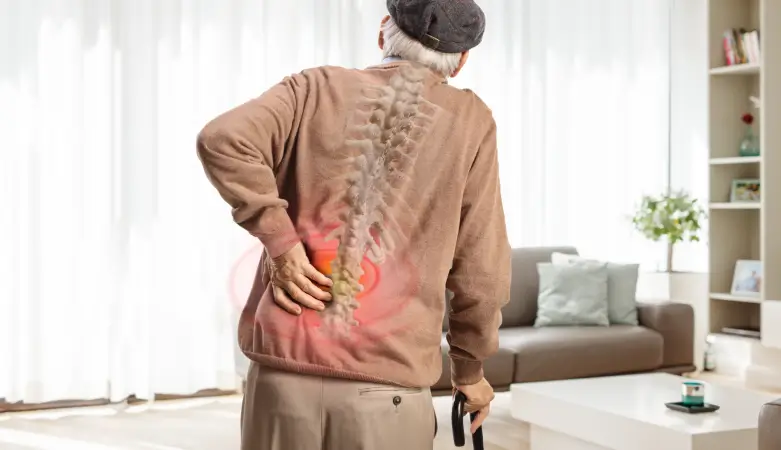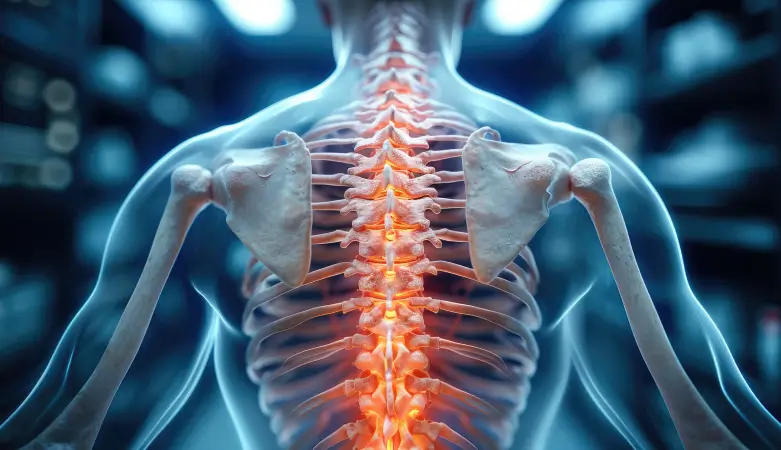Our 2-Month Regenerative Medicine Program
Initial Evaluation
- Clinical exam and send for imaging if needed
Consultation
- Discuss imaging findings to Diagnose and start treatment plan
Physical Therapy
- Setting up for appropriate therapy
Oral Medication
- Start appropriate medication if needed
Oral Supplementation
- Discuss Type 2 Collagen peptides if needed
Joint Therapy
- Advanced ice machine and Moist heat application
Laser Treatment
- High Intensity IV laser therapy
Injection Treatment
- PRP, Stem Cell, and Viscosupplementation based on individual needs
Comprehensive Treatment for Lumbar Back Pain
Lumbar back pain is a leading cause of disability worldwide, affecting millions each year. Whether your pain is acute or chronic, it can disrupt work, exercise, and daily activities.
At Comprehensive Spine Center – RGM, we specialize in advanced regenerative therapies that relieve pain and heal and restore spinal structures. Our minimally invasive, non-surgical back pain treatments—including Platelet-Rich Plasma (PRP) Therapy and Stem Cell Therapy—use your body’s natural healing abilities to repair damaged tissues and restore mobility.

Understanding Lumbar Back Pain: Causes & Anatomy
The lumbar spine (lower back) consists of five vertebrae (L1-L5) and supports most of the body’s weight. It allows for bending, twisting, and stability, but its heavy workload makes it prone to injuries, wear, and chronic back pain.
Common Sources of Lumbar Pain
- Intervertebral Discs – Act as shock absorbers between vertebrae.
- Degeneration or herniation can cause discogenic pain and sciatica (radiating leg pain).
- Facet Joints – Small stabilizing joints that enable flexibility. Arthritis and inflammation in these joints lead to stiffness and localized back pain.
- Ligaments & Muscles – Provide spinal support. Strains, sprains, and repetitive stress injuries can cause muscle spasms and restricted movement.

Diagnosing Lumbar Back Pain
At Comprehensive Spine Center – RGM, we conduct thorough evaluations to pinpoint the root cause of your pain.
Key Diagnostic Questions
- Is the lumbar back pain localized, or does it radiate to the legs?
- Does it worsen with movement or prolonged sitting?
- Are there symptoms like numbness, tingling, or weakness?
- Did the pain develop gradually or result from an injury?
Accurate diagnosis = Effective treatment
Struggling with lower back pain?

Advanced Regenerative Therapies for Lumbar Back Pain
Unlike surgery, regenerative medicine focuses on healing damaged spinal structures, reducing inflammation, and restoring function.
Platelet-Rich Plasma (PRP) Therapy
PRP therapy is an advanced treatment that utilizes your body’s own platelets to stimulate healing and tissue repair.
PRP Injection Process
Step 1: Blood Draw – A small sample of your blood is collected.
Step 2: Centrifugation – The blood is spun to isolate healing platelets.
Step 3: PRP Extraction – The concentrated platelet-rich plasma is prepared.
Step 4: Fluoroscopic-Guided Injection – PRP is precisely injected into the affected area.
Step 5: Recovery & Healing – Mild soreness may occur, but normal activities can resume within days.
Effective for: Degenerative disc disease, arthritis, soft tissue injuries.
Stem Cell Therapy
Stem Cell Therapy harnesses your body’s own stem cells to repair damaged discs, joints, and ligaments.
How Stem Cell Therapy Works
- Step 1: Consultation & Evaluation – A comprehensive assessment of your condition.
- Step 2: Bone Marrow Extraction – Stem cells are collected from the hip bone.
- Step 3: Processing & Injection – Stem cells are concentrated and injected into the affected lumbar area.
- Step 4: Recovery & Follow-Up – Gradual pain relief occurs over weeks to months.
Ideal for: Chronic back pain, disc degeneration, arthritis.
When to See a Doctor for Lumbar Back Pain
Seek medical attention if you experience:
- Lumbar back pain lasting longer than 3 weeks
- Radiating pain, numbness, or tingling in the legs (sciatica)
- Weakness or difficulty walking
- Pain that worsens at night or while resting
- Loss of bladder or bowel control (Seek emergency care immediately!)

Research & Evidence Supporting PRP & Stem Cell Therapy
- Study #1: PRP Therapy for Lumbar Disc Degeneration
✔ Findings: PRP significantly reduces pain and improves mobility.
✔ Results: 40% pain reduction within 6 months.
📖 Source: Min Cheol Chang & Donghwi Park, J Pain Res. 2021. - Study #2: Stem Cell Therapy for Chronic Low Back Pain
✔ Findings: Patients reported significant lower back pain relief and improved function.
✔ Results: 80% experienced long-term relief and reduced disability.
📖 Source: Atluri, S. et al., Pain Physician. 2022. - Study #3: Bone Marrow Stem Cells for Spinal Degeneration
✔ Findings: Stem cell therapy reduced opioid use, pain levels, and increased disc height.
✔ Results: MRI scans confirmed spinal disc regeneration.
📖 Source: El-Kadiry, A. et al., Frontiers in Medicine. 2021.
These studies highlight regenerative medicine as a powerful alternative to surgery.

Why Choose Comprehensive Spine Center - Regenerative Medicine?
- Personalized Care – Every treatment plan is customized to your needs.
- Non-Surgical Approach – Minimally invasive procedures with little to no downtime.
- Leading-Edge Treatments – PRP & Stem Cell Therapy promotes natural healing.
- Board-Certified Specialists – Experts in spinal health & regenerative medicine.
Our goal is to help you live pain-free—without surgery.
Ready to Take the Next Step?
If you’re struggling with lower back pain and seeking a non-surgical, regenerative solution, we’re here to help.
Schedule your consultation today!

FAQs
Lower back pain on the right side can result from muscle strain, herniated discs, arthritis, or sacroiliac joint dysfunction. Getting a proper diagnosis is essential to determine the best lumbar spine pain treatment for your condition. If the pain persists, a specialist can help identify the root cause and recommend appropriate treatment.
Effective lumbar back pain treatment options include physical therapy, pain management, and regenerative medicine therapies like PRP injections and stem cell therapy, which promote natural healing. At CSC RGM, we focus on minimally invasive treatments that help restore spinal function without surgery.
Regenerative medicine for back pain, such as PRP and stem cell therapy, works by stimulating tissue repair and reducing inflammation in the lumbar spine. These treatments are particularly beneficial for patients looking to avoid surgery while achieving long-term pain relief. CSC RGM specializes in regenerative approaches personalized to your specific condition.
Non-surgical lower back pain treatment includes physical therapy treatment for back pain, regenerative therapies like PRP & stem cell therapy, and lifestyle modifications to strengthen the spine. Depending on your condition, CSC RGM can design a personalized treatment plan to help you regain mobility and reduce pain.
You should consult a back pain doctor if your pain lasts more than three weeks, radiates to your legs, worsens at night, or is accompanied by numbness, weakness, or difficulty walking. CSC RGM provides advanced diagnostics and treatment for persistent lumbar back pain.
Physical therapy treatment for back pain strengthens the muscles supporting the spine, improves flexibility, and reduces pain. If conservative treatments aren’t enough, combining physical therapy with regenerative medicine—offered at CSC RGM—can provide enhanced results.
PRP therapy uses concentrated platelets to accelerate healing, while stem cell therapy helps repair damaged spinal tissues by generating new cells. Both are effective regenerative back treatments and are available at CSC RGM for patients seeking non-surgical back pain relief.
Yes, regenerative medicine back pain treatments like PRP and stem cell therapy offer long-term relief by addressing the underlying cause of lumbar back pain rather than just masking symptoms. Many patients at CSC RGM have experienced significant improvement through these therapies.
Results vary, but many patients notice improvements within a few weeks to months as their body heals after PRP or stem cell injections for lumbar spine pain treatment. At CSC RGM, our board-certified specialists provide ongoing guidance throughout your recovery.
If you’re looking for advanced back pain therapy treatment, scheduling a consultation with CSC RGM is easy. Visit our website or call us to discuss your back pain treatment options and start your journey to a pain-free life.

